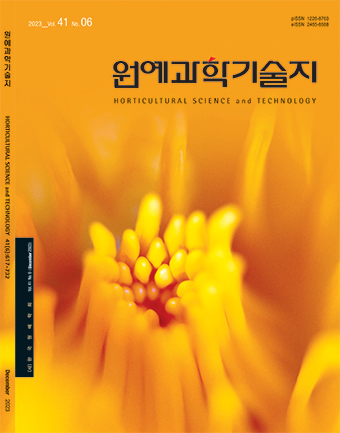- Publisher :KOREAN SOCIETY FOR HORTICULTURAL SCIENCE
- Publisher(Ko) :원예과학기술지
- Journal Title :Horticultural Science and Technology
- Journal Title(Ko) :원예과학기술지
- Volume : 35
- No :3
- Pages :361-372
- DOI :https://doi.org/10.12972/kjhst.20170038
Abstract
References
Beecher GR (1998) Nutrient content of tomato and tomato products. Proc Soc Exp Biol Med 218:98-100. https://
doi.org/10.3181/00379727-218-44282a Bhandari, SR, Cho, MC, Lee, JG (2016) Genotypic variation in carotenoid, ascorbic acid, total phenolic, and flavonoid
contents, and antioxidant activity in selected tomato breeding lines. Hortic. Environ. Biotechnol. 57, 440-452.
https://10.1007/s13580-016-0144-3 Bouma J, Varallyay G, Bates NH (1998) Principal land use changes anticipated in Europe. Agric Ecosyst Environ 67:103-119. https://doi.org/10.1016/S0167-8809(97)00109-6 Brandt S, Pė k Z, Baran (2006) Lycopene content and colour of ripening tomatoes as affected by environmental conditions. J Sci Food
Agric 86:568-572. https://doi.org/10.1002/jsfa.2390 Clinton S. K (2006) Lycopene: chemistry, biology, and implications for human health and disease. Nurition Rev. 56:35-51. https://
doi.org/10.1111/j.1753-4887.1998.tb01691.x D’Souza M, Singha S, Ingle M (1992) Lycopene concentration of tomato fruit can be estimated from chromaticity values. HortScience.
27:465-466 FAO (2013) FAO Stactical Databases of Agrculture. Available via http://faostat3.fao.org/download/Q/QC/E Accessed 28 August 2016 Gail H, Sofia LC (2003) Tomato-A guide to the pleasure of choosing, growing, and cooking. DK Publishing. pp. 6. Galiana-Balaguer L, Roselló S, Herrero-Martinez JM, Maquieira A, Nuez F (2001) Determination of -ascorbic acid in Lycopersicon fruits
by capillary zone electrophoresis. Anal Biochem. 296:163–218. https://doi.org/10.1006/abio.2001.5297 Kuti O, Konuru HB (2005) Effects of genotype and cultivation environment on lycopene content in re-ripe tomatoes. J Sci Food Agric.
85:2021-2026. https://doi.org/10.1002/jsfa.2205 Menrad K (2003) Market and marketing of functional food in Europe. J Food Eng. 56:181-188. https://doi.org/10.1016/S0260-8774(02)00247-9 Miller RG (1974) The jackknife: a review. Biometrika. 61:1–15. https://doi.org/10.1093/biomet/61.1.1 Radzevičius A, Karklelienė R, Viškelis P, Bobinas Č, Bobinaitė R, Sakalauskienė S. (2009) Tomato (Lycopersicon esculentum Mill.) fruit
quality and physiological parameters at different ripening stages of Lithuanian cultivars. Agron Res. 7:S712-S718 Jaymie S, Gustavo R, Itai N, Josh T, Atticus J, Audrey D, Jack H, Nancy D, Simon G et al. (2010) Tomato Analyzer Color Test User Manual
Version 3. Available via http://www.oardc.ohio-state.edu/vanderknaap/files/Color_Test_3.0_Manual.pdf Accessed 28 August 2016 Wayne W. Fish, Penelope Perkins-Veazie, Julie K. Collins (2002) A Quantitative Assay for Lycopene That Utilizes Reduced Volumes of
Organic Solvents, Jourrnal of Food composition and Analysis. 15:309–317 Watada A, Norris K, Worthington J, Massie D (1976) Estimation of chlorophyll and carotenoid contents of whole tomato by light
absorbance technique. J. Food Sci. 41: 329-332. https://doi.org/10.1111/j.1365-2621.1976.tb00611.x
Information
Journal Informaiton
 Horticultural Science and Technology
Horticultural Science and Technology
Journal Informaiton
Journal Informaiton - close
 Horticultural Science and Technology
Horticultural Science and Technology
- About This Journal
- Editorial Board
- Instructions for Authors
- Publishing Policies
- Academic Journals’ Code of Ethics












